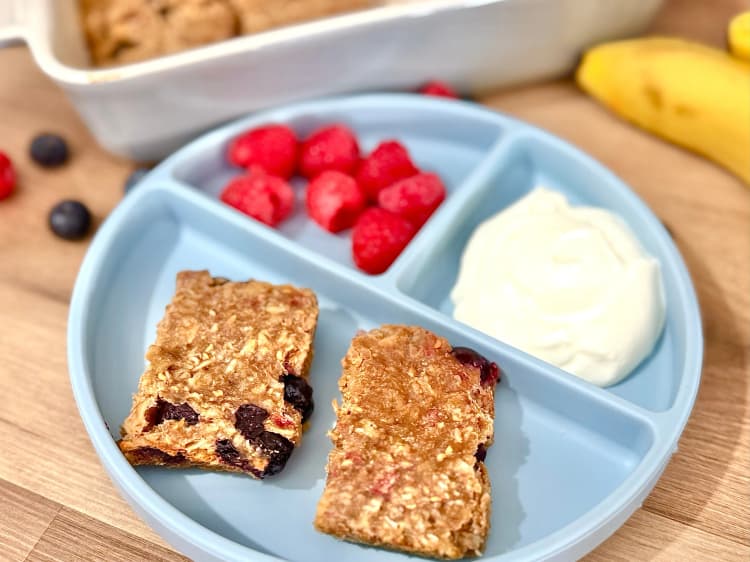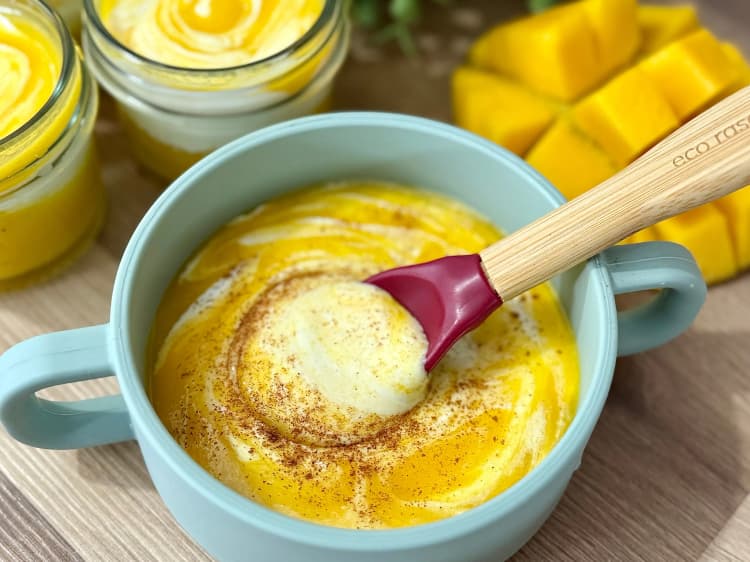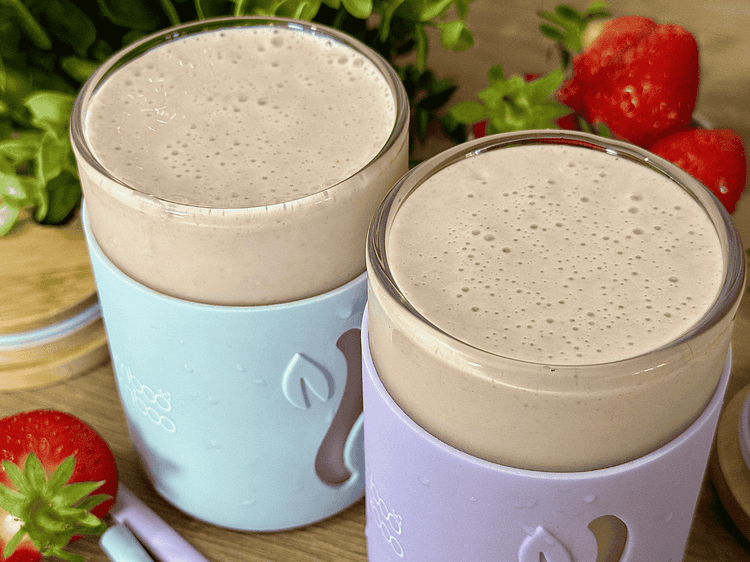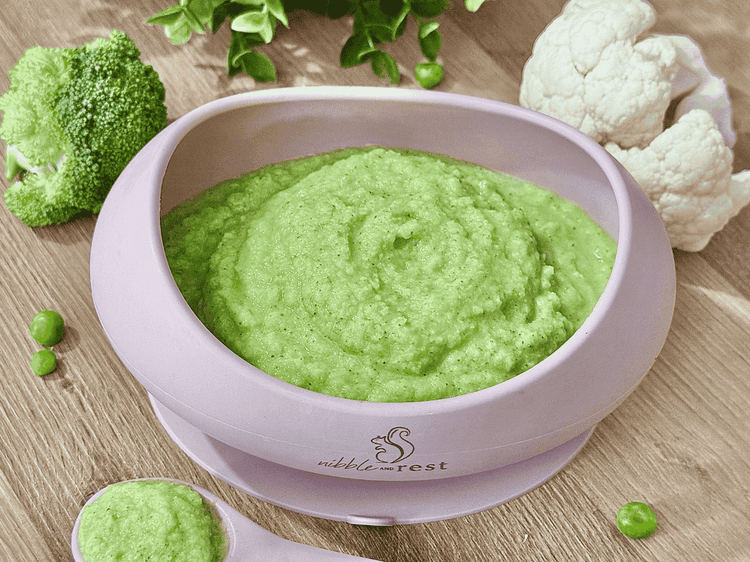Warm Veggie Purée

Written by Kenny Ekerin
Fact Checked by Mindsmaking Professionals
2nd, September, 2025
This post may contain affiliate links. Please read our disclosure policy.
A silky, veggie-packed purée made with butternut squash, carrot, and red pepper—perfect for little ones starting solids. Gentle, nourishing, and freezer-friendly, it’s a wholesome go-to for busy parents.

Here's a warm, gentle veggie purée that's perfect for little ones just starting their journey with solids. Packed with naturally sweet and mild vegetables like butternut squash, carrot, and red pepper, this purée is not only delicious but also full of vitamins A and C, fibre, and antioxidants to support your baby's growth and immunity.
The soft, velvety texture makes it perfect for babies starting solids around 6 months, and it’s easily customizable; you can stir in a little breastmilk or formula for a creamier finish. Plus, it’s freezer-friendly, making it a lifesaver for busy parents who want a wholesome, homemade option always ready to go.
Why You’d Love This Baby Puree
- Naturally smooth and gentle on little tummies
- Rich in fiber, vitamins, and antioxidants
- Freezes beautifully, which is ideal for batch cooking
- Easily adaptable for allergies or special diets
- A smart, stress-free way to add Veggies any day
Prep Time: 8 minutes
Cook Time: 30 minutes
Yields: 3–4 portions
How to Make these Warm Veggie Puree
Ingredients
- 1 tbsp olive oil
- 1 small onion, chopped
- 60g red bell pepper, cored, deseeded, and chopped
- 1 medium carrot, peeled and chopped
- 1 cup butternut squash, peeled and chopped
- 1 cup water (plus extra if needed)
- ½ cup frozen peas (or fresh)

Read This Next

Recipe Ebook
Essential Guide to Starting Solids for Babies 6 Months+ - LBH Top 70 Baby Puree & Porridge Recipes eBook.
Start your baby’s solids journey with confidence using this "70 Baby Purees & Porridges" eBook! Created with care, this digital guide is packed with nutrient-rich recipes for babies 6 months and older, including purees and porridges tailored to each stage of your baby’s development.
Instructions
1. Sauté the Base Veggies
Start by warming the olive oil in a medium saucepan over medium heat. Add the chopped onion, red bell pepper, and carrot. Sauté gently for about 3 minutes, stirring often. This step softens the veggies and enhances their natural sweetness, forming a flavourful base for the purée.
2. Add the Butternut Squash and Water
Stir in the butternut squash cubes and pour in 1 cup of water. The water will create steam, which helps to cook the squash evenly while keeping the mix moist.
3. Simmer Until Soft
Bring the mixture to a gentle boil, then cover the pan with a lid. Reduce the heat to low and let it simmer for 20–25 minutes. You’ll know it’s ready when the vegetables are fork-tender and soft enough to mash easily.
4. Add Peas & Finish Cooking
Add the frozen peas and simmer for another 3–4 minutes. The peas will soften quickly and add a lovely pop of color and sweetness. If the mixture looks too dry, feel free to add an extra splash of water to loosen it slightly.
5. Blend to Desired Texture
Once all the veggies are soft, remove the pan from heat. Use a hand blender directly in the pan or transfer everything into a blender/food processor. Blend until you achieve a silky smooth purée or leave it slightly chunky for older babies developing their chewing skills.

Tips for success
Chop Veggies Evenly
Aim to cut all your vegetables into similar-sized pieces, about 1–2 cm cubes. This ensures they cook at the same rate, so you won’t end up with some pieces overcooked and others still firm. Uniform cooking is key to achieving a smooth, lump-free purée that’s gentle on your baby’s palate.
Simmer Low and Slow
Once you’ve brought the veggies to a gentle boil, reduce the heat to low and cover the pan. Slow simmering helps the vegetables soften completely, intensifying their natural sweetness and making them easier to blend into a creamy consistency.
Adjust Liquid Gradually
The amount of water you’ll need can vary depending on how much liquid is released from the veggies during cooking. Start with 1 cup, but if the purée feels too thick after blending, gradually add extra water (or breastmilk/formula) a tablespoon at a time until it reaches the right texture for your baby’s stage; thin for beginners, thicker for more experienced eaters.
Use Fresh or Frozen Peas
Frozen peas are flash-frozen at peak ripeness, so they often have just as much (or even more) sweetness and nutrition compared to fresh ones. Don’t hesitate to use them straight from the freezer for convenience and consistency in flavor and color.
Serving suggestions
Serve as a Simple First Purée
This recipe is perfect as a gentle, single-texture purée for babies starting solids. Serve it slightly warm (not hot) directly on a spoon, allowing your baby to explore the taste and texture at their own pace.
Boost Satiety with Add-Ins
For older babies or when you want a more filling meal, you can stir in a spoonful of baby rice, mashed potatoes, or even cooked quinoa. These additions add extra calories and bulk, making the meal more satisfying for growing appetites.
Thin Out for Younger Babies
If the purée feels too thick, thin it out with a splash of breastmilk, formula, or cooled boiled water. This not only adjusts the texture but also adds familiarity for breastfed/formula-fed babies.
Toddler-Friendly Serving Ideas
For toddlers who prefer finger foods, spread the purée on toast fingers, or use it as a dip for soft-cooked vegetable sticks (like steamed carrot batons, cucumber sticks, or sweet potato wedges). It can also work as a nutritious “sauce” over small pasta shapes.
How to store
Refrigerating
Once the purée has cooled to room temperature, transfer it to an airtight container and refrigerate immediately. It will stay fresh for up to 3 days. Make sure to portion only what you need for immediate feeding and avoid double-dipping spoons, as saliva can introduce bacteria.
Freezing
Portion the cooled purée into ice cube trays or small freezer-safe containers. Once frozen solid, transfer the cubes into labeled freezer bags. This makes it easy to thaw single portions as needed. The purée can be stored in the freezer for up to 3 months without losing quality.
Reheating
To thaw, either defrost overnight in the fridge or use a microwave on a low setting, stirring and checking the temperature thoroughly before serving. Always test the purée's warmth with the inside of your wrist to avoid burns. For a smoother texture after freezing, give it a quick stir after reheating to reincorporate any separated liquid.
Nutrition
(Per serving, approximate)
- Calories: 110 kcal
- Carbohydrates: 18g
- Protein: 2g
- Fat: 4g
- Saturated Fat: 0.6g
- Polyunsaturated Fat: 0.5g
- Monounsaturated Fat: 2.8g
- Trans Fat: 0g
- Cholesterol: 0mg
- Sodium: 28mg
- Potassium: 460mg
- Fiber: 4g
- Sugar: 6g
- Vitamin A: 6,250 IU
- Vitamin C: 42mg
- Calcium: 40mg
- Iron: 1mg
Note: Nutritional values are estimates and may vary based on ingredient brands and portion sizes.
Frequently Asked Questions
Can I prepare this purée ahead of time for meal prep?
Yes! This recipe is designed with busy parents in mind. You can make a large batch, portion it into freezer trays, and have ready-to-go servings for weeks. Just thaw and reheat as needed. It's a huge time-saver during hectic weekdays when cooking from scratch isn't feasible.
Can I swap out the vegetables in this recipe?
Yes! The recipe is very flexible. You can replace butternut squash with sweet potatoes, swap carrots for parsnips, or add zucchini for a softer texture. Just ensure that whichever veggies you use are cooked until very tender to maintain a safe texture for babies.
Is this recipe suitable for baby-led weaning (BLW)?
While the recipe is a spoon-fed purée, you can adapt it for BLW. For example, use it as a dip for steamed veggie sticks, toast fingers, or soft-cooked pasta. You can also reduce blending time to create a thicker, mash-like consistency suitable for self-feeding with pre-loaded spoons.
Can I make this recipe without using oil?
Yes! If you’re avoiding oil, simply sauté the vegetables in a splash of water or low-sodium vegetable broth. This will soften them adequately while still keeping the recipe light and suitable for very young babies or those on a low-fat diet.
How can I make the purée creamier for older babies?
To enrich the purée’s texture, stir in a spoonful of plain, full-fat Greek yogurt (for babies 9 months+), cottage cheese, or a little extra breastmilk/formula. This adds creaminess and a slight protein boost.
At what age can I introduce this purée to my baby?
This purée is suitable from 6 months onwards, assuming your baby shows signs of readiness for solids (good head control, interest in food, etc.). Always start with thin purées for first feeds, gradually progressing to thicker textures as your baby becomes more confident.
What if the purée is too thick after blending?
It’s easy to fix! Simply add extra cooled boiled water, breastmilk, or formula, a little at a time, and blend again until you reach the desired consistency. Remember, it should easily drop from a spoon for first-timers.
Can I double this recipe for batch cooking?
Yes! Doubling or tripling this recipe works perfectly for batch cooking. Just make sure your saucepan or cooking pot is large enough to accommodate the extra volume, and you may need to extend the simmering time slightly until all veggies are tender.
Was this article helpful?
How many stars are you giving this article?
Leave a comment
Your email address will not be published.
Comments
More From Recipe

Eggless Banana Applesauce Muffins

Protein Berry Bar

Easy Homemade Strawberry Jam

Homemade Mango Yoghurt

Strawberry Banana Smoothie

Easy Veggie Baby Purée
Get new recipes to your inbox
Subscribe to our weekly newsletter and get new recipes sent to your inbox!